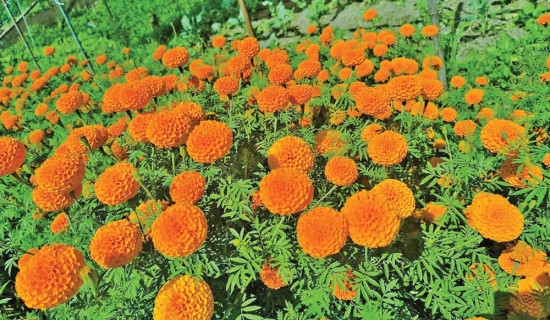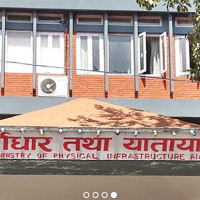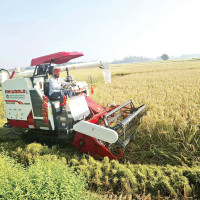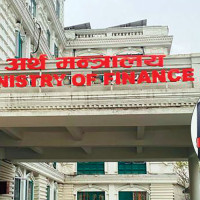- Tuesday, 21 October 2025
69% paddy plantation completes
By A Staff Reporter,Kathmandu, July 17: Paddy plantation has been completed on 68.6 per cent of rice fields across the country as of July 15 (Monday). According to the statistics of the Ministry of Agriculture and Livestock Development, paddy plantation has been carried out only in 959,746 hectares out of 1.39 million hectares of paddy fields.
According to Ministry, this year's plantation is 12 percentage points higher than the same period last year. The paddy plantation was completed in about 56.5 per cent during the same period last year.
By now, paddy plantation has completed in the largest area of paddy field in Sudurpashchim Province followed by Karnali and Bagmati Province.
In Sudurpashchim Province, paddy plantation has completed in 95 per cent (165,847 hectares) while 86.2 per cent (36,129 hectares) in Karnali and 69.2 per cent (79,258 hectares) of paddy fields in Bagmati Province by Monday.
Paddy is grown in around 174,576 hectares in the Sudurpashchim Province, 41,904 hectares in Karnali Province and 114,561 hectares in Bagmati Province.
Paddy plantation has completed in 67.4 per cent (64,746 hectares) in Gandaki, 66.7 per cent (207,839 hectares) in Lumbini and 61.7 per cent (170,450 hectares) of the total paddy field in Koshi Province till date.
Paddy is being cultivated in around 96,053 hectares of land in Gandaki Province, 311,643 hectares of land in Lumbini Province and 276,386 hectares of land in Koshi Province.
Likewise, the lowest paddy plantation has been done in Madhes Province where plantation has completed in 61.5 per cent.
The paddy plantation has been completed in around 235,475 hectares of land of the total paddy field of 383,150 hectares in Madhes Province.
According to Dr. Hari Bahadur KC, spokesperson and joint secretary at the Ministry of Agriculture and Livestock Development, owing to continuous rainfall, paddy plantation was moving on in full swing across the country, including Madhes Province for the last one week. Even though paddy plantation is comparatively low in Madhes Province than others during the review period, plantation was higher by 33 percentage points during the review period as compared to same period last year.
The paddy was planted in only 28.4 per cent of the total paddy fields by mid-July last year.
“Madhes Province is considered to be the hub of rice production. The paddy plantation has increased by around by 36 percentage points within a week in the province. The present growth of plantation in the province is a matter of happiness,” he said.
As paddy plantation and production in the country is fully dependent on the rainfalls due to lack of proper irrigation infrastructure, the continuous rainfall for the last week has contributed to increased plantation, he said.
The area of paddy cultivation this year is estimated to decrease by 100,000 hectares as compared to last year. It was projected last year that 1.5 million hectares of land would be cultivated with rice.
According to Dr. KC, paddy plantation is expected to be done in more than 95 per cent of the paddy fields of 1.4 million hectares this year if the monsoon remains favourable.
Dr. K.C said that paddy plantation would continue in various places of Bagmati, Koshi, Lumbini and Madhes Province till the end of Shrawan (mid-August).
He said that with regular monsoon, easy availability of chemical fertilisers across the country had also contributed to make significant achievement in paddy plantation this year as compared to same period last year.
He assured that there would be no shortage of chemical fetilisers at least for the paddy crops this year.
Around 77,500 tonnes of chemical fertilisers are in stock at present while the process to bring additional fertiliser has already started, which would prevent any shortage, he said.
Out of 77,500 tonnes of stock fertilisers, around 39,400 tonnes of urea, 29,100 tonnes of DAP and 9,000 tonnes of potash are in stock at the depots of Agriculture Inputs Company Limited and Salt Trading Corporation (STC).
The AICL and STC, the two public enterprises, are importing and distributing subsidised chemical fertilisers to the farmers as per the budget allocated by the government.
KC said that additional 25,000 tonnes of DAP fertilisers under the G2G agreement with India was in the process of entering the country.
Similarly, additional 30,000 tonnes of urea imported by the Agricultural Inputs Company Limited (AICL) had started entering Nepal and it was expected that 30,000 tonnes of urea would start entering Nepal from August.









-original-thumb.jpg)







